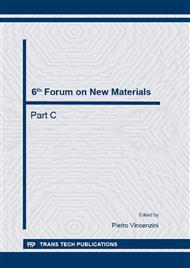p.50
p.56
p.66
p.72
p.78
p.84
p.91
p.96
p.100
Two-Terminal Non-Volatile Memory Devices Using Silicon Nanowires as the Storage Medium
Abstract:
In the recent years a notable progress in the miniaturisation of electronic devices has been achieved in which the main component that has shown great interest is electronic memory. However, miniaturisation is reaching its limit. Alternative materials, manufacturing equipment and architectures for the storage devices are considered. In this work, an investigation on the suitability of silicon nanowires as the charge storage medium in two-terminal non-volatile memory devices is presented. Silicon nanostructures have attracted attention due to their small size, interesting properties and their potential integration into electronic devices. The two-terminal memory devices presented in this work, have a simple structure of silicon nanowires sandwiched between dielectric layers (silicon nitride) on glass substrate with thermally evaporated aluminium bottom and top contacts. The silicon nanostructures and the dielectric layer were deposited by Plasma Enhanced Chemical Vapour Deposition (PECVD) technique. The electrical behaviour of the memory cell was examined by Current-Voltage (I-V), data retention time (Current-time) and write-read-erase-read measurements. Metal-Insulator-Semiconductor (MIS) structures were also prepared for further analysis. The same silicon nanowires were embedded into the MIS capacitors and Capacitance-Voltage (C-V) analysis was conducted. Strong I-V and C-V hysteresis as well as an electrical bistability were detected. The memory effect is observed by this electrical bistability of the device that was able to switch between high and low conductivity states.
Info:
Periodical:
Pages:
78-83
Citation:
Online since:
October 2014
Authors:
Price:
Сopyright:
© 2014 Trans Tech Publications Ltd. All Rights Reserved
Share:
Citation:


